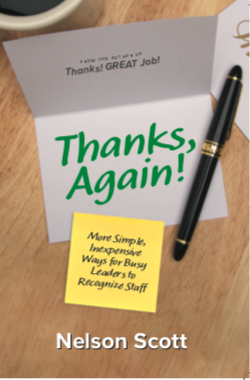
The Question: Could the same components that make staff recognition “GREAT” also be applied when providing feedback related to poor performance?
Answer: The simple answer is, “Yes.” All the ingredients that are part of meaningful staff recognition could also be used to provide effective feedback when a staff member’s performance falls short of expectations.
Before we get to that, a quick recap: The acronym GREAT minds us of the five ingredients of meaningful staff recognition. Recognition must be Genuine—inspired by a sincere sense of appreciation. You make your message of gratitude stronger when you include one or more of the other ingredients—Relevant, Explicit, Appropriate and Timely.
Providing Genuine feedback is rooted in fairness. When staff members perform well, praise them. When they don’t, let them know that you are not satisfied, that you expect better and that you are committed to supporting their efforts to improve.
When you recognize staff members when they do well and criticize them when they don’t, you make both types of feedback credible. Both recognition and criticism seem Genuine.
Both types of feedback should be linked to what the organization says is important, as captured in its mission and vision statements, values and goals. That is, all feedback should be Relevant. Show staff members how their behaviour reflects the values of the organization or helps it achieve its goals with recognition. Let them know when behaviour is inconsistent with the organization’s values or makes achieving its goals more difficult.
Recognition is more meaningful when your specific description of the behaviour makes the recognition Explicit. It shows you are paying attention. Feedback for underperformance should include facts. To generate improved performance, you and the staff member need to reach a mutual understanding of the behaviour you observed before you are able to provide your assessment and you and the staff member can identify a course to improvement.
There are more opportunities to deliver Appropriate staff recognition than there are to make negative feedback appropriate. Appropriate recognition is tied to what’s important to the recipient—their interests and hobbies, the treats they enjoy, their career goals, etc.—and their preference for recognition that is public or delivered in private.
Certainly, it is never appropriate to criticize performance in public. Negative feedback should always be delivered in private.
Negative feedback can be made Appropriate by highlighting the positive impact of improved performance on an individual’s ability to achieve their career goals.
Finally, all feedback should be Timely—delivered soon after the action that prompted the feedback. The greater the gap between performance and feedback the less effective it becomes. When feedback is delayed, the memory of the behaviour that inspired it fades.
Apart from during performance reviews, where both types of feedback are expected, recognition and criticism should be kept separate. In particular, avoid using praise to buffer criticism.
For example, never follow praise with the word “but,” such as, “You did a good job on this report, but it was late.” Used this way, but becomes a verbal eraser that diminishes the positive message that proceeded it. The focus is only on what didn’t meet expectations.
Another practice to avoid is the advice to, “Always sandwich criticism between two layers of praise.” Repeated exposure to this “sandwich technique” causes staff to listen for the other shoe to fall because if praise is often followed by criticism. They will ignore the praise that sandwiches the criticism because they believe that only what’s in middle of the sandwich matters to you.
As a leader, you will need to deliver both positive and negative feedback. You should praise behaviour you want to see more often and criticize behaviour that you wish to see less often. When you apply the acronym GREAT, you make staff recognition more meaningful and performance feedback aimed at improvement is more effective.
==
When you read my new book Thanks, Again! More Simple, Inexpensive Ways for Busy Leaders to Recognize Staff, you will discover a section devoted to the barriers to meaningful staff recognition—words and practices that diminish the impact of messages of appreciation. Sign up to receive regular updates on the progress toward the book’s launch and to immediately.


